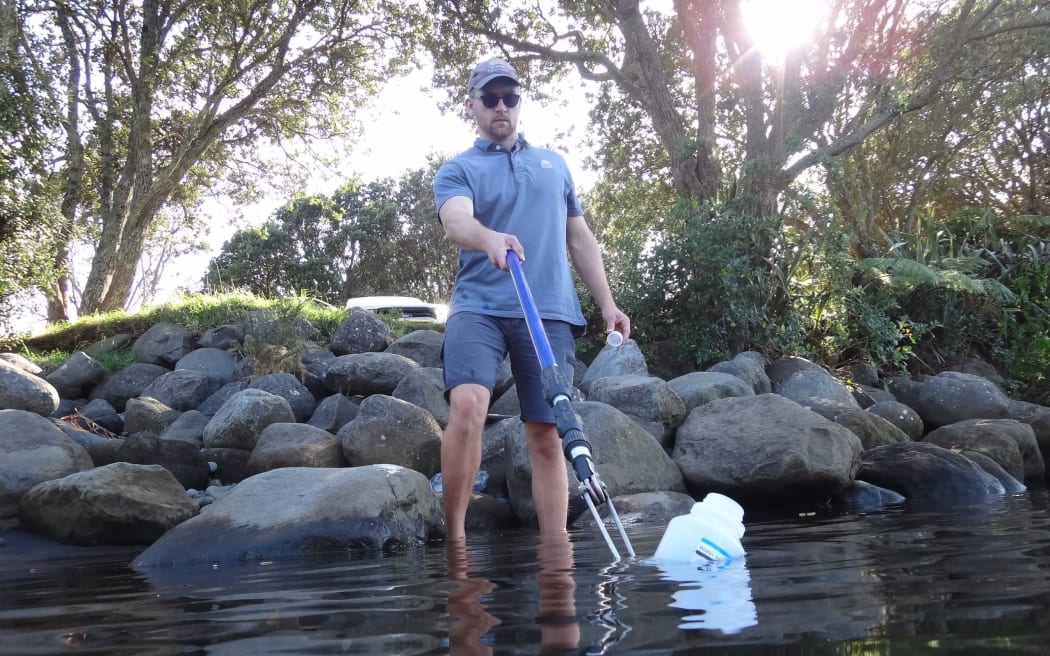
Would-be swimmers in Tongaporutu River, North Taranaki, are advised to exercise caution. Photo: Keith Murray / Flickr / CC BY-NC-ND 2.0
All of Taranaki's river swimming spots have rated poorly for the risk of getting sick from a faecal bug in the latest report card on the region's water quality.
The risk of illness is graded according to long-term water testing data in Taranaki Regional Council's annual report on its Can I Swim Here? programme.

Every one of the 17 rivers tested were graded "poor" for Escherichia coli (E coli) bacteria risk - the lowest possible rating.
Three of five swimming spots at lakes were also rated "poor", while two remaining lake sites gained the top "excellent" grade for E coli.
The swimming report card explains that the long-term assessment is required under government freshwater rules.
"Sites that have been graded poor are considered to be below the national bottom line; a minimum standard, below which action is required to deliver water quality improvements.
"With regards to E coli at swim spots, regional councils are required to work with communities to develop action plans for achieving these improvements."
But the report says the results should be seen as interim because test data is only goes back one or two years - not the preferred five years.

Individual tests, such as at Corbett Park, have found rivers suitable for swimming at least half of the time. Photo: Supplied
Beyond the overall grading, the results of individual water tests during the 2022-23 season are less grim.
Half of the freshwater tests (243 of 484) found the water suitable for swimming at the time of sampling. The E coli numbers were at "cautionary" levels 21 per cent of the time and "unsuitable for swimming" for the remaining 29 per cent.
E coli lives in the gut of warm-blooded animals: in rivers it indicates other disease-causing bacteria, viruses and protozoa are also present - such as campylobacter.
High E coli levels at a few Taranaki estuaries are blamed on wild birds, but most testing sites are contaminated by farm animals.
Toxic blue-green cyanobacteria growing on riverbed rocks or drifting in lake water can also make swimmers sick.
During the 2022-23 season, 56 per cent of cyanobacteria surveys found the monitored rivers were suitable for swimming, with cautionary levels during 35 per cent of surveys, and conditions unsuitable for swimming 9 per cent of the time.
In lakes, cyanobacteria levels were suitable for swimming in 65 per cent of samples, at cautionary status in 5 per cent of tests, and unsuitable for swimming the remaining 31 per cent.
Fortnightly testing for cyanobacteria is upgraded to weekly when pollution guidelines are exceeded.
The report says government freshwater rules demand enforceable rules and limits for bacteria and that TRC is currently working on this under a new Freshwater Plan which must be notified by December 2024.
The sea is safer: the council tests beaches for enterococci bacteria which survive longer in saltwater.
At popular beach sites 87 per cent of tests (341 of 394) indicated water suitable for swimming at the time of sampling. Enterococci numbers exceeded the cautionary guideline in six percent of samples and while 8 per cent of tests showed water unsuitable for swimming.
From now until the end of March, Taranaki Regional Council will test weekly for the harmful bacteria at 41 rivers, lakes and beaches.
Results are posted to the council's 'Can I Swim Here?' webpage, as well as www.lawa.org.nz on Thursday evening.
Any unexplained contamination sparks a follow-up sample on Friday, with results available on Monday.
In a report to the council's policy and planning committee for its meeting next Tuesday, environment quality director Abby Matthews said samples were collected only during fine weather before November 2021.
"Sampling now occurs weekly, regardless of weather conditions. This change brings the monitoring programme into line with new national policy requirements.
"The previous dry weather monitoring approach helped to characterise recreational water quality when people are more likely to swim.
"However, we know that some people across Taranaki are still getting in the water during wet weather (or soon after), so it is important to collect data during those conditions too."
TRC water quality scientist Angela Collins said water quality could change quickly, so swimmers should take their own precautions.
"The biggest one is to avoid swimming for three days after heavy or prolonged rainfall. That means any rain that leads to surface run-off, where you might see lots of water flowing in the gutters."
Local Democracy Reporting is funded through NZ On Air

